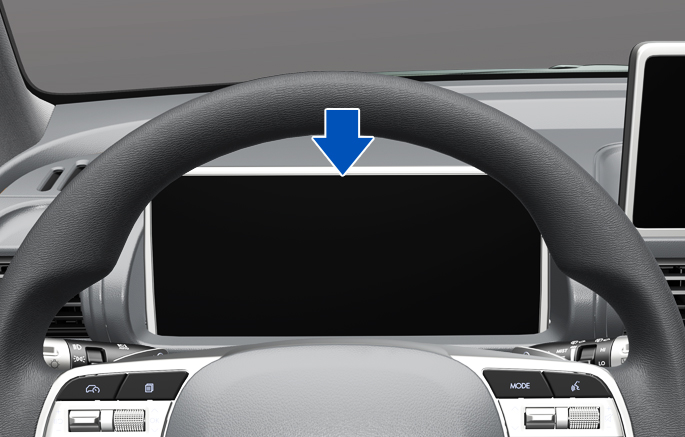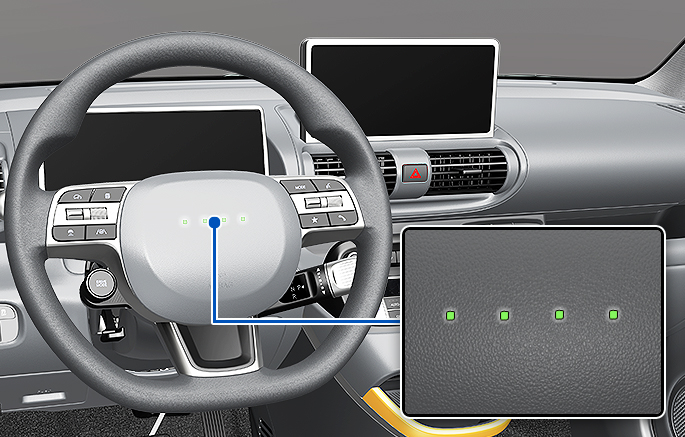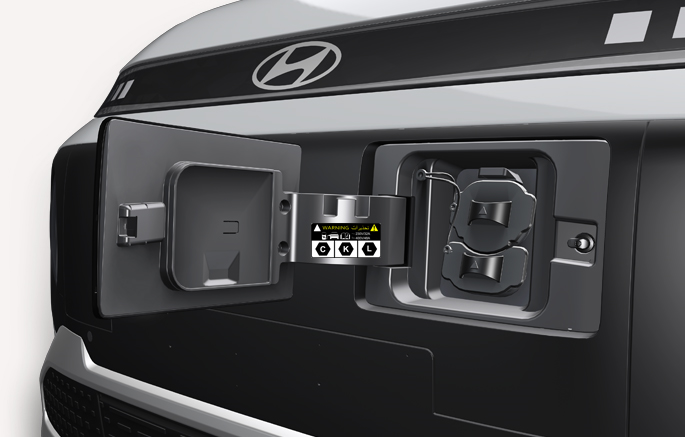Checking basic information on charging your electric vehicle
Before charging your vehicle, check and understand the information such as the estimated charging time according to the charge type, checking the State of Charge (SOC), and setting the charger lock mode.
The charge types for electric vehicle are as follows:
-
AC charge: The electric vehicle is charged via an AC charger at public charging stations. An AC charger may require an AC charging cable (sold separately).
-
DC charge: You can charge at high speeds at public charging stations. Refer to the respective company's manual that is provided for each DC charger type.
-
Portable charge: If the vehicle cannot be moved to a public charging station due to a lack of battery power, the vehicle can be charged with household electricity, using the 220 V/230 V portable charger (sold separately).
-
Battery performance and life may deteriorate if the DC charger is used constantly. Use of DC charging should be minimized in order to help prolong high voltage battery life. Use AC charging unless DC charging is necessary.
-
The electrical outlet at home must comply with regulations and can safely accommodate the Voltage, Current (Amps), and Power (Watts) ratings specified on the portable charger. If not, the vehicle may not be charged or safety hazards, such as fire, may occur.
-
If the power distributor exceeds its capacity while charging the vehicle with a portable charger at home, the power to home may be cut off or a fire may occur.
-
If you use a portable charger to charge your electric vehicle with household electricity, you are charged on your household electricity bill.
The estimated charging time for each charging type is as follows:
|
Charging type |
Charging time |
Charge level (Minimum - Maximum) |
Charging condition (Temperature) |
||
|
Standard battery |
Long range battery, CROSS battery |
||||
|
AC charge |
230 V/16 A/3 phases |
About 4 hours |
About 4 hours 35 minutes |
10-100 % |
Battery temperature (25 °C) |
|
220 V/48 A |
About 4 hours 15 minute |
About 4 hours 45 minutes |
|||
|
DC charge |
150 kW |
About 30 minutes |
About 30 minutes |
10-80 % |
|
|
50 kW |
About 55 minutes |
About 55 minutes |
|||
|
Portable charge |
230 V/12 A |
About 16 hours 55 minutes |
About 19 hours 40 minutes |
10-100 % |
|
|
220 V/12 A |
About 17 hours 45 minutes |
About 20 hours 40 minutes |
|||
-
Depending on the condition and duration of use of the high voltage battery, charger specifications, and ambient temperature, the time required for charging the high voltage battery may vary.
-
If the charger is worn out, exposed, or there exists any type of damage, charging may stop for your safety. Use another charger that works normally.
-
When charging the battery, an additional 3 minutes may be required to check battery condition.

2C_ChargingDoorIndicator
Check the charging state on the cluster display to monitor the battery capacity of the high voltage and estimated charging time.
When charging starts, the charging state will be displayed on the cluster display.
-
With the vehicle on, the charging state will be displayed continuously.
-
When the vehicle is off, the charging state will be displayed for up to 1 minute. The charging state will be displayed continuously when a door is opened.
-
The charging light located on the center of steering wheel shows the total battery power remaining.
-
The charge level is divided into four levels, from 0 to 100 %.
-

2C_FrontBumperIndicator
|
Charge level indicator |
Charge level |

|
0–24 % |

|
25–49 % |

|
50–74 % |

|
75–100 % |
Open the charging door and check the information on the charging label. The charging label shows safety symbols and the rated input specifications for charging.

2C_ChargingLabelLocation

1C_ChargingLabel
|
No. |
Name |
Description |
|
(1) |
Warning for high voltage |
Indicates a device with a risk of electric shock. |
|
(2) |
Warning/Caution symbol |
Indicates a device that may cause property damage, serious injury or death if not operated carefully. |
|
(3) |
Rated voltage and maximum charging current |
Indicates the type of input current (AC) and the rated voltage range (V) and charging current (A) when AC charging. |
You can lock the charging connector during AC charging to prevent unintended detachment of the charging connector from the vehicle.
The connector is automatically locked during DC charging or while using the V2L function, regardless of the settings of charging connector locking mode applied to the vehicle.
-
When DC charging is complete, the charging connector is unlocked automatically.
-
After using electricity, you can unlock the charging connector by pressing the switch on the V2L connector to turn off the power and unlock the vehicle door.
-
Select User Settings > ECO Vehicle > Lock Charging Cable > Always/While charging/ Do not lock in the instrument cluster or select EV >
ƺ (MENU) > EV settings > Charging connector locking mode > Auto/ Lock/ Unlock on the Home screen of the infotainment system, to set the locking mode of the charging connector.The available locking mode options are as follows:
-
Always/Auto: Locks the connector automatically whenever the charging connector is plugged into the charging inlet.
-
While charging/Lock: Locks the connector automatically only while charging is in progress after the charging connector is properly connected to the vehicle.
-
Do not lock/Unlock: The connector unlocks regardless of the state of charging.
Press the charging connector release button, disconnect the connector.
Be careful to theft of the charging cable.
-
If the unlock button is not functioning properly due to a discharged battery or abnormal electrical wiring, the charging connector cannot be disconnected from the vehicle.
Do not disconnect the charging connector forcibly. Doing so may damage the charging connector or the charging inlet on the vehicle.
If the charging connector is not disconnected due to battery being fully discharged or a wiring failure, open the hood and pull the emergency cable.

2C_EmergencyChargingCable
-
If the charging connector does not disconnect after pulling the emergency cable, we recommend that your vehicle be inspected by an authorized HYUNDAI dealer.